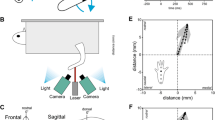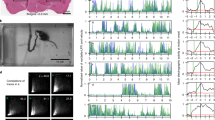Abstract
Complexity in movement planning, arising from diverse temporal and spatial sources, places a computational burden on the central nervous system. However, the efficacy with which humans can perform natural, highly trained movements suggests that they have evolved effective behavioral strategies that simplify the computational burden. The specific aim of our research was to use three-dimensional high-speed video to determine whether the tail nociceptive withdrawal response (NWR) to noxious heat stimuli delivered at locations that varied both circumferentially and rostral-caudally on the tail depended on the location of the stimulus in spinalized rats. In particular, we sought to determine whether the movement strategy was categorical (limited number of directions) or continuous (any variation in stimulus location results in a variation in response direction). In spinalized rats, localized, noxious heat stimuli were delivered at eight locations circumferentially around the tail and at five rostral–caudal levels. Our results demonstrate that at all rostral–caudal levels, response movement direction was bimodal regardless of circumferential stimulus location—either ~ 64° left or right of ventral. However, in spite of tight clustering, movement direction varied significantly but weakly according to circumferential location, in that responses to stimuli were more lateral for lateral stimulus locations. In contrast, changes in stimulus level strongly affected movement direction, in that a localized bend response closely matched the level of the stimulus. Together, our results demonstrate, based on movement analysis in spinalized rats, that the NWR employs a hybrid categorical–continuous strategy that may minimize the harmful consequences of noxious stimuli.





Similar content being viewed by others
References
Andersen OK, Sonnenborg FA, Arendt-Nielsen L (1999) Modular organization of human leg withdrawal reflexes elicited by electrical stimulation of the foot sole. Muscle Nerve 22:1520–1530. https://doi.org/10.1002/(SICI)1097-4598(199911)22:11%3c1520:AID-MUS6%3e3.0.CO;2-V
Andersen OK, Sonnenborg F, Matjacic Z, Arendt-Nielsen L (2003) Foot-sole reflex receptive fields for human withdrawal reflexes in symmetrical standing position. Exp Brain Res 152:434–443. https://doi.org/10.1007/s00221-003-1550-1
Andersen OK, Finnerup NB, Spaich EG, Jensen TS, Arendt-Nielsen L (2004) Expansion of nociceptive withdrawal reflex receptive fields in spinal cord injured humans. Clin Neurophysiol 115:2798–2810. https://doi.org/10.1016/j.clinph.2004.07.003
Bennett DJ, Gorassini M, Fouad K, Sanelli L, Han Y, Cheng J (1999) Spasticity in rats with sacral spinal cord injury. J Neurotrauma 16:69–84. https://doi.org/10.1089/neu.1999.16.69
Bernstein N (1967) The coordination and regulation of movement. Pergamon Press, London
Brink EE, Pfaff DW (1980) Vertebral muscles of the back and tail of the albino rat (Rattus norvegicus albinus). Brain Behav Evol 17:24–47. https://doi.org/10.1159/000121789
Brody H (2006) Unforced errors and error reduction in tennis. Br J Sports Med 40:397–400
Carstens E, Wilson C (1993) Rat tail flick reflex: magnitude measurement of stimulus-response function, suppression by morphine and habituation. J Neurophysiol 70:630–639. https://doi.org/10.1152/jn.1993.70.2.630
Cattaert D, Le Ray D (2001) Adaptive motor control in crayfish. Prog Neurobiol 63:199–240. https://doi.org/10.1016/S0301-0082(00)00030-7
Chirikjian GS, Burdick JW (1994) A hyper-redundant manipulator. IEEE Robot Autom Mag 1:22–29. https://doi.org/10.1109/100.388263
Cleland CL, Bauer RE (2002) Spatial transformations in the withdrawal response of the tail in intact and spinalized rats. J Neurosci 22:5265–5270. https://doi.org/10.1523/JNEUROSCI.22-13-05265.2002
Cleland CL, Rymer WZ (1990) Neural mechanisms underlying the clasp-knife reflex in the cat. I. Characteristics of the reflex. J Neurophysiol 64:1303–1318. https://doi.org/10.1152/jn.1990.64.4.1303
Cleland CL, Lim FY, Gebhart GF (1994) Pentobarbital prevents the development of C-fiber-induced hyperalgesia in the rat. Pain 57:31–43. https://doi.org/10.1016/0304-3959(94)90105-8
Cleland CL, Esquivel CE, Davis HT (2017) The nociceptive withdrawal response of the foot in the spinalized rat exhibits limited dependence on stimulus location. Exp Brain Res 235:2027–2038. https://doi.org/10.1007/s00221-017-4940-5
Creed RS, Sherrington C (1926) Observations on concurrent contraction of flexor muscles in the flexion reflex. Proc R Soc Lond Ser B 100:258–267. https://doi.org/10.1098/rspb.1926.0046
Eaton RC (1984) Neural Mechanisms of Startle Behavior. Plenum, New York
Eccles RM, Lundberg A (1959) Supraspinal control of interneurones mediating spinal reflexes. J Physiol (Lond) 147:565–584. https://doi.org/10.1113/jphysiol.1959.sp006262
Faisal AA, Selen LP, Wolpert DM (2008) Noise in the nervous system. Nat Rev Neurosci 9:292–303. https://doi.org/10.1038/nrn2258
Gordon CJ (1990) Thermal biology of the laboratory rat. Physiol Behav 47:963–991. https://doi.org/10.1016/0031-9384(90)90025-Y
Grimby L (1963) Normal plantar response: integration of flexor and extensor reflex components. J Neurol Neurosurg Psychiatry 26:39–50. https://doi.org/10.1136/jnnp.26.1.39
Grimby L (1965) Pathological plantar response. I. Flexor and extensor components in early and late reflex parts. J Neurol Neurosurg Psychiatry 28:469–472. https://doi.org/10.1136/jnnp.28.6.469
Hagbarth KE (1952) Excitatory and inhibitory skin areas for flexor and extensor motoneurons. Acta Physiol Scand Suppl 26:1–58
Hagbarth KE, Finer BL (1963) The plasticity of human withdrawal reflexes to noxious skin stimuli in lower limbs. In: Moruzzi G, Fessard AS, Jasper HH (eds) Brain mechanisms, progress in brain research, vol 1. Elsevier, Amsterdam, pp 65–78. https://doi.org/10.1016/S0079-6123(08)60589-0
Hellon RF, Hensel H, Schäfer K (1975) Thermal receptors in the scrotum of the rat. J Physiol (Lond) 248:349–357. https://doi.org/10.1113/jphysiol.1975.sp010978
Hollerbach JM, Flash T (1982) Dynamic interactions between limb segments during planar arm movement. Biol Cybern 44:67–77. https://doi.org/10.1007/BF00353957
Hooper SL, Guschlbauer C, Blümel M, von Twickel A, Hobbs KH, Thuma JB, Büschges A (2016) Muscles: non-linear transformers of motor neuron activity. In: Prilutsky BI, Edwards DH (eds) Neuromechanical modeling of posture and locomotion. Springer, Berlin, pp 163–194
Hori H, Fukutani T, Nakane H, Iino S, Nojyo Y (2011) Participation of ventral and dorsal tail muscles in bending movements of rat tail. Anat Sci Int 86:194–203. https://doi.org/10.1007/s12565-011-0110-1
Kanou M, Ohshima M, Inoue J (1999) The air-puff evoked escape behavior of the cricket Gryllus bimaculatus and its compensational recovery after cercal ablations. Zool Sci 16:71–79. https://doi.org/10.2108/zsj.16.71
Kirkwood PA, Schomburg ED, Steffens H (1987) Facilitatory interaction in spinal reflex pathways from nociceptive cutaneous afferents and identified secondary spindle afferents in the cat. Exp Brain Res 68:657–660. https://doi.org/10.1007/BF00249808
Kofler M (2003) Functional organization of exteroceptive inhibition following nociceptive electrical fingertip stimulation in humans. Clin Neurophysiol 114:973–980. https://doi.org/10.1016/S1388-2457(03)00060-9
Le Bars D, Gozariu M, Cadden SW (2001) Animal models of nociception. Pharmacol Rev 53:597–652
Levinsson A, Luo X, Holmberg H, Schouenborg J (1999) Developmental tuning in a spinal nociceptive system: effects of neonatal spinalization. J Neurosci 19:10397–10403. https://doi.org/10.1523/JNEUROSCI.19-23-10397.1999
Lewis JE, Kristan WB Jr (1998) Quantitative analysis of a directed behavior in the medicinal leech: implications for organizing motor output. J Neurosci 18:1571–1582. https://doi.org/10.1523/JNEUROSCI.18-04-01571.1998
Mohammadi A, Byrne Rodgers J, Kotera I, Ryu WS (2013) Behavioral response of Caenorhabditis elegans to localized thermal stimuli. BMC Neurosci 14:66. https://doi.org/10.1186/1471-2202-14-66
Peterson CL, Riley ZA, Krepkovich ET, Murray WM, Perreault EJ (2014) Withdrawal reflexes in the upper limb adapt to arm posture and stimulus location. Muscle Nerve 49:716–723. https://doi.org/10.1002/mus.23987
Schmit BD, Hornby TG, Tysseling-Mattiace VM, Benz EN (2003) Absence of local sign withdrawal in chronic human spinal cord injury. J Neurophysiol 90:3232–3241. https://doi.org/10.1152/jn.00924.2002
Schouenborg J, Kalliomaki J (1990) Functional organization of the nociceptive withdrawal reflexes. I. Activation of hindlimb muscles in the rat. Exp Brain Res 83:67–78. https://doi.org/10.1007/BF00232194
Schouenborg J, Holmberg H, Weng HR (1992) Functional organization of the nociceptive withdrawal reflexes. II. Changes of excitability and receptive fields after spinalization in the rat. Exp Brain Res 90:469–478. https://doi.org/10.1007/BF00230929
Sherrington CS (1910) Flexion-reflex of the limb, crossed extension-reflex, and reflex stepping and standing. J Physiol (Lond) 40:28–121. https://doi.org/10.1113/jphysiol.1910.sp001362
Steffens H, Schomburg ED (1993) Convergence in segmental reflex pathways from nociceptive and non-nociceptive afferents to alpha-motoneurones in the cat. J Physiol (Lond) 466:191–211
Sumbre G, Fiorito G, Flash T, Hochner B (2006) Octopuses use a human-like strategy to control precise point-to-point arm movements. Curr Biol 16:767–772. https://doi.org/10.1016/j.cub.2006.02.069
Thelin J, Schouenborg J (2008) Spatial encoding in spinal sensorimotor circuits differs in different wild type mice strains. BMC Neurosci 9:45. https://doi.org/10.1186/1471-2202-9-45
Turvey MT (1990) Coordination. Am Psychol 45:938–953. https://doi.org/10.1037/0003-066X.45.8.938
Tzabazis A, Klyukinov M, Manering N, Nemenov MI, Shafer SL, Yeomans DC (2005) Differential activation of trigeminal C or Adelta nociceptors by infrared diode laser in rats: behavioral evidence. Brain Res 1037:148–156. https://doi.org/10.1016/j.brainres.2005.01.019
Yeomans DC, Proudfit HK (1996) Nociceptive responses to high and low rates of noxious cutaneous heating are mediated by different nociceptors in the rat: electrophysiological evidence. Pain 68:141–150. https://doi.org/10.1016/S0304-3959(96)03177-6
Zar JH (1984) Biostatistical analysis. Prentice-Hall, Englewoods Cliffs
Funding
The funding was provided by Thomas F. and Kate Miller Jeffress Memorial Trust (J-975).
Author information
Authors and Affiliations
Corresponding author
Additional information
Publisher's Note
Springer Nature remains neutral with regard to jurisdictional claims in published maps and institutional affiliations.
Rights and permissions
About this article
Cite this article
Bence, C.M., Cleland, C.L. The nociceptive withdrawal response of the tail in the spinalized rat employs a hybrid categorical–continuous spatial mapping strategy. Exp Brain Res 237, 1551–1561 (2019). https://doi.org/10.1007/s00221-019-05527-w
Received:
Accepted:
Published:
Issue Date:
DOI: https://doi.org/10.1007/s00221-019-05527-w




